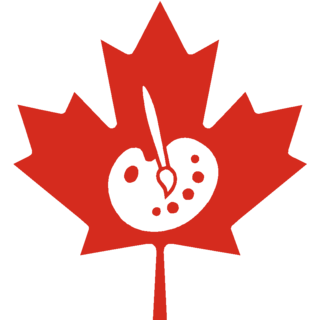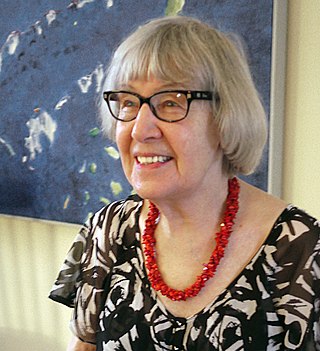
Norval Morrisseau, also known as Copper Thunderbird, was an Indigenous Canadian artist from the Bingwi Neyaashi Anishinaabek First Nation. He is widely regarded as the grandfather of contemporary Indigenous art in Canada. Known as the "Picasso of the North," Morrisseau created works depicting the legends of his people, the cultural and political tensions between native Canadian and European traditions, his existential struggles, and his deep spirituality and mysticism. His style is characterized by thick black outlines and bright colors. He founded the Woodlands School of Canadian art and was a prominent member of the “Indian Group of Seven."

Woodlands style, also called the Woodlands school, Legend painting, Medicine painting, and Anishnabe painting, is a genre of painting among First Nations and Native American artists from the Great Lakes area, including northern Ontario and southwestern Manitoba. The majority of the Woodlands artists are Anishinaabeg, notably the Ojibwe, Odawa, and Potawatomi, as well as the Oji-Cree and the Cree.

Rebecca Belmore is a Canadian interdisciplinary Anishinaabekwe artist who is notable for politically conscious and socially aware performance and installation work. She is Ojibwe and a member of Obishikokaang. Belmore currently lives in Toronto, Ontario.

Pudlo Pudlat, was a Canadian Inuit artist whose preferred medium was a combination of acrylic wash and coloured pencils. His works are in the collections of most Canadian museums. At his death in 1992, Pudlo left a body of work that included more than 4000 drawings and 200 prints.
Jackson Beardy was an Indigenous Oji-Cree Anishinaabe artist born in Canada. His works are characterized by scenes from Ojibwe and Cree oral history and many focus on the relationship between humans and nature. He belonged to the Woodland School of Art and was a prominent member of the Indian Group of Seven. His work has contributed to the recognition of Indigenous contemporary art within Canada.

The Professional Native Indian Artists Incorporation (PNIAI) was a group of First Nations artists from Canada, with one from the United States. Founded in November 1973, they were Indigenous painters who exhibited in the mainstream art world.
Triple K Co-operative Incorporated is a Canadian Native-run silk-screen company in Red Lake, Ontario that produced high quality limited editions of several artist within the Woodland School of Art from 1973 till the early 1980s. Now it is an online and bricks-and-mortar gallery in Thunder Bay, Ontario.

Robert Houle is a Saulteaux First Nations Canadian artist, curator, critic, and educator. Houle has had an active curatorial and artistic practice since the mid-1970s. He played an important role in bridging the gap between contemporary First Nations artists and the broader Canadian art scene through his writing and involvement in early important high-profile exhibitions such as Land, Spirit, Power: First Nations at the National Gallery of Canada. As an artist, Houle has shown both nationally and internationally. He is predominantly a painter working in the tradition of Abstraction, yet he has also embraced a pop sensibility by incorporating everyday images and text into his works. His work addresses lingering aspects of colonialism and their effects on First Nation peoples. Houle often appropriates historical photographs and texts, repurposing and combining them with Anishnaabe language and traditionally used materials such as porcupine quills within his works.

The Art Gallery of Peterborough is a free admission, non-profit public art gallery in Peterborough, Ontario, Canada. A registered charity that depends on the support of its members, it was founded in 1974 by an independent board of volunteers. In 1977 it was given the Foster House by the City of Peterborough, a historical residence set in parkland beside Little Lake. In 1979 The gallery expanded to its current size of 11,000 square feet (1,000 m2) with the construction of its modernist wing designed by Crang & Boake architects.

Joseph M. Sanchez is an artist and museum curator.
Bonnie Devine is a Serpent River Ojibwa installation artist, performance artist, sculptor, curator, and writer from Serpent River First Nation, who lives and works in Toronto, Ontario. She is currently an associate professor at OCAD University and the founding chair of its Indigenous Visual Cultural Program.
Susan Andrina Ross CM, was a Canadian painter, printmaker, and illustrator from Port Arthur, Ontario who is best known for her portraits of Native and Inuit peoples as well as Arctic landscapes. Her work is valuable both for its artistry and for its historical significance since she captured many images of a passing way of life. In 2002 she was awarded the Order of Canada in the Visual Arts.

Gathie Falk is a Canadian painter, sculptor, installation and performance artist based in Vancouver, British Columbia. Since the 1960s, she has created works that consider the simple beauty of everyday items and daily rituals.
Duke Redbird is an Indigenous Canadian poet, journalist, activist, businessman, actor and administrator, best known as a key figure in the development of First Nations literature in Canada.

Michelle LaVallee is a Canadian curator, artist, and educator. She is Ojibway and a member of the Chippewas of Nawash Unceded First Nation in Cape Croker, Ontario. She has BFA (2000) and BEd (2004) degrees from York University in Toronto.
Skawennati is a First Nations (Kahnawakeronon) multimedia artist, best known for her online works as well as Machinima that explore contemporary Indigenous cultures, and what Indigenous life might look like in futures inspired by science fiction. She served as the 2019 Indigenous Knowledge Holder at McGill University. In 2011, she was awarded an Eiteljorg Contemporary Art Fellowship which recognized her as one of "the best and most relevant native artists."
Tania Willard is an Indigenous Canadian multidisciplinary artist, graphic designer, and curator, known for mixing traditional Indigenous arts practices with contemporary ideas. Willard is from the Secwepemc nation, of the British Columbia interior, Canada.
Morgan Wood is a curator and artist who is Stony Mountain Cree. Her family is from the Michel Callihou Band in Alberta and her great-grandmother was Victoria Callihou. Wood received a Bachelor of Indian Art from the First Nations University of Canada, at the University of Regina in Regina, Saskatchewan.
Joan Willsher-Martel was a painter of abstract and pointillist landscapes, in watercolour, drawings and oils.
Carol Podedworny is a Canadian museum director and curator who advocated for the inclusion of contemporary Indigenous art and for Indigenous voices in Canadian museums in a career spanning over 40 years. Besides post-contact First Nations art, she is interested in contemporary Canadian art, and a diverse range of art history and art, including its material practice. She is the author or co-author of many books, catalogues and essays which investigate these subjects, as well as issues of medical inquiry.









